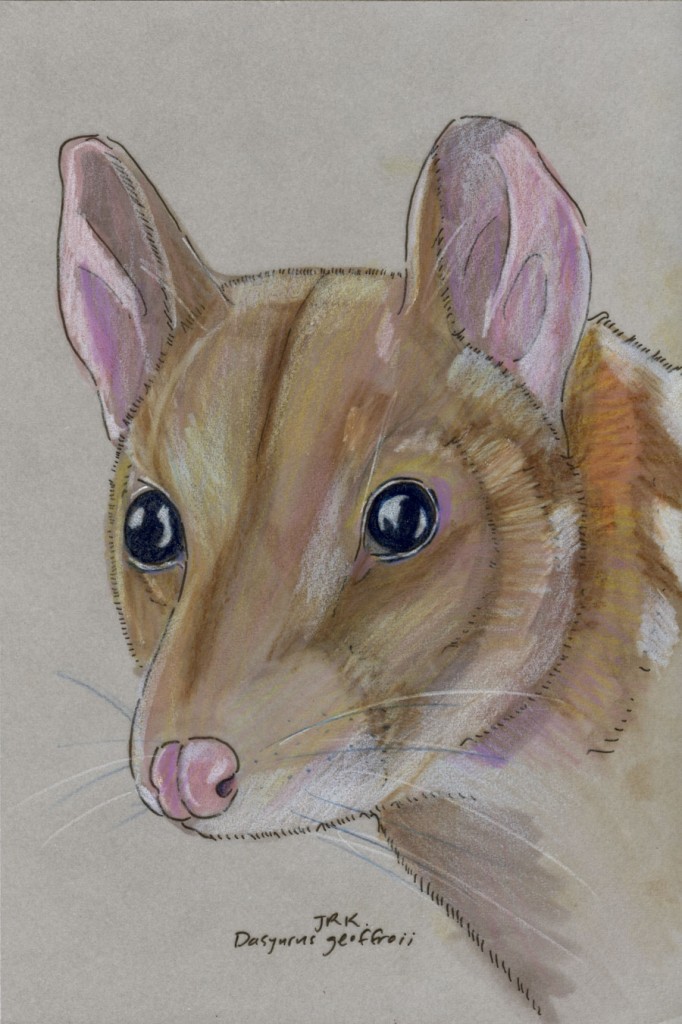Geoffroy Week: Chuditch (Dasyurus geoffroii)
Geoffroy Week continues at the Daily Mammal. Étienne Geoffroy Saint-Hilaire planned to join the clergy as a teenager. He became a canon of the church at 15 and was earnestly studying the world beyond this one when his eyes were opened to the mysteries of the world where we live right now. He was turning away from Catholicism and toward Deism when the French Revolution blew everything up. He joined the revolution but kept up his studies, earning a law degree and then entering medical school, all before he was 21. His revolutionary credentials allowed him to arrange for the release of a famous mineralogist (René Just Haüy) who had been imprisoned during the Reign of Terror; in gratitude, one of the mineralogist’s friends set Geoffroy up with a gig at the Jardin des Plantes, filling in for a nobleman scientist who had fled the Revolution and its guillotine. When the Jardin des Plantes became the Muséum d’Histoire Naturelle, Geoffroy was appointed its Chair of Mammals and Birds, as I mentioned on Sunday.
One of Geoffroy’s jobs was to fill the new menagerie with animals. In the book New Worlds, New Animals: From Menagerie to Zoological Park in the Nineteenth Century, we learn that
“the manner in which Etienne obtained animals for the menagerie provides an exemplary chapter in opportunistic zoo management…In the fall of 1793, the police began to clear the streets of animal acts, spectacles, and other attractions that might incite a mob. They took the animals and their keepers to the museum, where the young professor, who acted without consultation from his superiors, accepted the animals and placed the keepers on salary as guardians.”
Joining the confiscated animals were some survivors from the menagerie at Versailles, including a lion and a quagga (one of my favorite animals, now extinct.)
One species that Geoffroy’s menagerie probably didn’t have was this chuditch, also known as the western quoll (or, in French, the chat marsupial de Geoffroy). While Geoffroy is the one who named the genus Dasyurus, which means hairy tail, this species wasn’t described until 1841, three years before Geoffroy’s death, by John Gould. He has an interesting story, too, but let’s cover it when we meet one of the five species named after him someday. Speaking of names, did you notice that geoffroii is the third kind of Geoffroy eponym we’ve seen? The others were geoffrensis and geoffroyi. I have no idea why they’re different or what the difference signifies.
The chuditch is a marsupial that lives in western Australia. It’s carnivorous and mostly nocturnal, hunting for invertebrates, birds, and reptiles at night after sleeping the day away in a hollow log. Chuditch mothers have up to half a dozen babies, which they haul around until the babies are too big to hang on any longer. The IUCN says that the chuditch is near threatened. Its range has decreased by 95 percent over the past 200 years thanks to habitat destruction by humans and wildfires. Another serious threat to the chuditch’s well being is the red fox, which was introduced to Australia in the 19th century for the British to hunt.


He has the sweetest face. I love this drawing.
Why, thank you. But according to my Safari Card, he may not be as sweet as he looks: “Ordinarily a shy animal the dasyure becomes ferocious when cornered; it turns to face its enemy, spitting, screeching, snarling and snapping. yet it can be tamed quite easily and gives a lot of pleasure as a pet.”